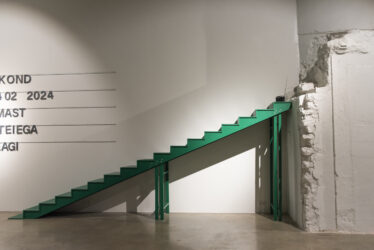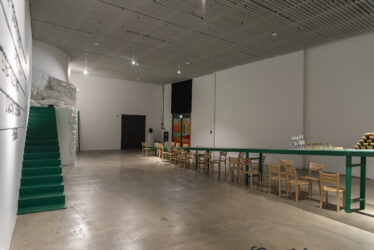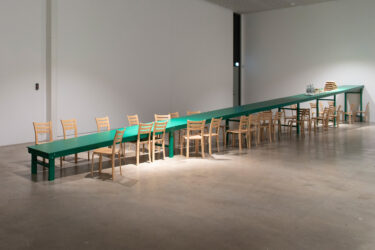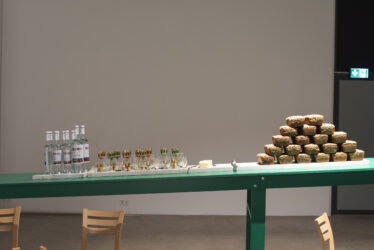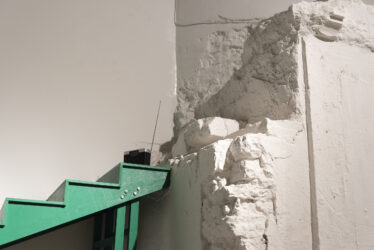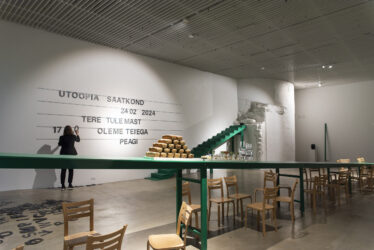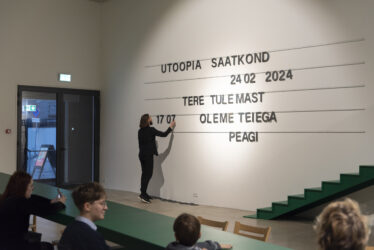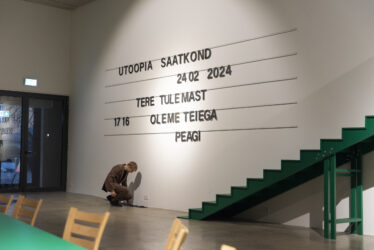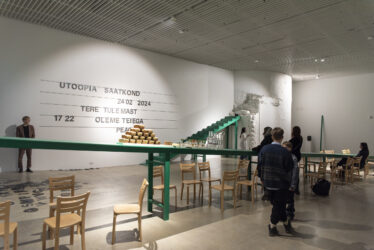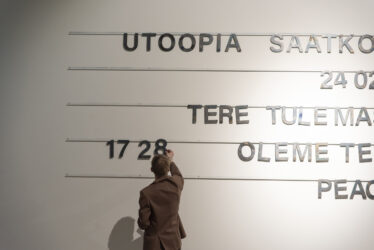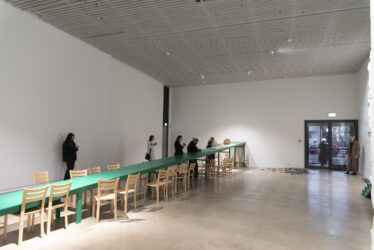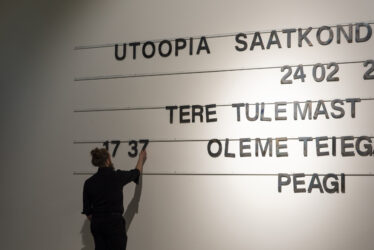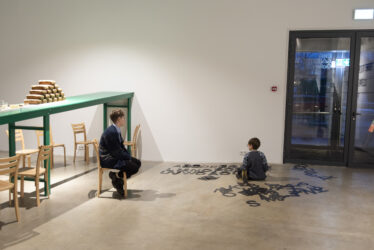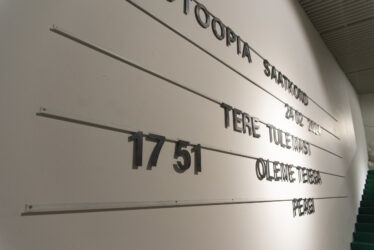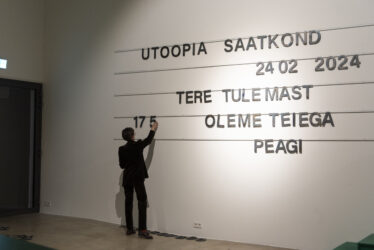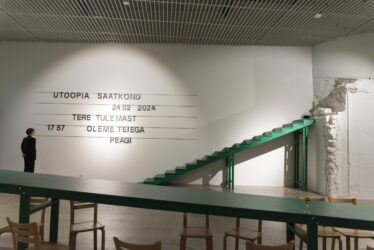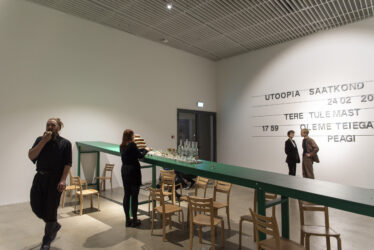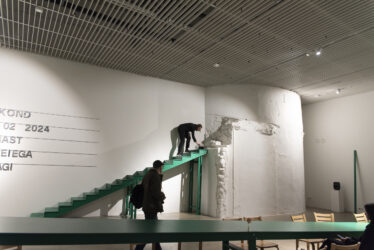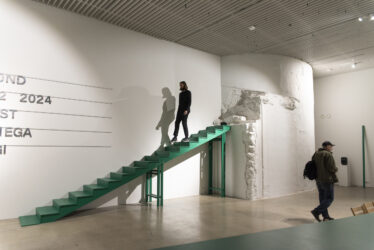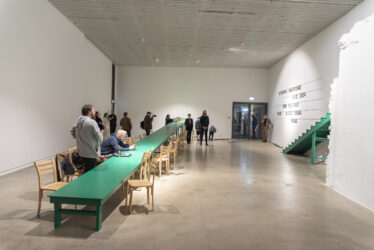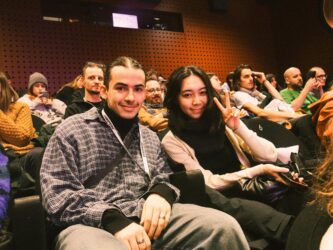Academic Affairs OfficeAccessory DesignAnimationArchitecture and Urban DesignArt EducationCenter for Flat TechnologiesCeramicsCultural Heritage and ConservationDepartmentsDesign and Technology FuturesDoctoral SchoolDrawingFacilities and WorkshopsFaculty of ArchitectureFaculty of Art and CultureFaculty of DesignFaculty of Fine ArtsFashion DesignFinancial DepartmentGalleryGlass ArtGraphic ArtGraphic DesignInstallation and SculptureInstitute of Art History and Visual CultureInternational OfficeIT OfficeJewellery and BlacksmithingLandscape ArchitectureLibraryLinnaehitus @enMaking SpaceNew MediaOffice of the RectorateOpen AcademyPaintingPerforming ArtsPhotographyProduct DesignRectorateResearch and Development OfficeScenographySupport UnitsTextile DesignUncategorizedUrban PlanningUrban Studies
Category: Faculty of Fine Arts
08.02.2024 — 01.03.2024
Sten Saarits in ARS Showroom
Contemporary Art
In Dialogue with Dissonance
ARS Showroom
09.02-01.03.2024
Opening: 08.02 at 18:00
“In Dialogue with Dissonance” invites viewers to engage in a practice of dialogue with the art space, its surroundings, and the unpredictable qualities of sound. “In Dialogue with Dissonance” is an installation that integrates live on-site sound, digital algorithm-based manipulations, and flashing signs bearing incoherent directives for active participation. The exhibition challenges visitors to question meaning-making, modes of interaction, and embrace the unpredictability of an ever-changing space.
The sound composition for 9 audio channels and 1 low frequency emitter was developed on location as a reflection on the space. The composition is only based on automation lanes that direct live input signals through various digital signal processors, the raw sound from passing cars, the space itself, vibrations in the architecture, and feedback events picked up by different microphones are mostly unpredictable. Live sounds are picked up by specialized devices, including a geophone originally designed for seismic measurements and a coil-type microphone that renders electromagnetic fields audible.
Sten Saarits is an interdisciplinary artist who works mainly with time-based media. As an avid field recordist, his installation works often utilize sound compositions comprising spoken words and auditory signifiers, constructing participatory and animated environments. Saarits’ practice commonly explores themes of overstimulation and cultural behavioral norms.
The exhibition is supported by Estonian Cultural Endowment and Estonian Artists’ Association
Posted by Andres Lõo — Permalink
Sten Saarits in ARS Showroom
Thursday 08 February, 2024 — Friday 01 March, 2024
Contemporary Art
In Dialogue with Dissonance
ARS Showroom
09.02-01.03.2024
Opening: 08.02 at 18:00
“In Dialogue with Dissonance” invites viewers to engage in a practice of dialogue with the art space, its surroundings, and the unpredictable qualities of sound. “In Dialogue with Dissonance” is an installation that integrates live on-site sound, digital algorithm-based manipulations, and flashing signs bearing incoherent directives for active participation. The exhibition challenges visitors to question meaning-making, modes of interaction, and embrace the unpredictability of an ever-changing space.
The sound composition for 9 audio channels and 1 low frequency emitter was developed on location as a reflection on the space. The composition is only based on automation lanes that direct live input signals through various digital signal processors, the raw sound from passing cars, the space itself, vibrations in the architecture, and feedback events picked up by different microphones are mostly unpredictable. Live sounds are picked up by specialized devices, including a geophone originally designed for seismic measurements and a coil-type microphone that renders electromagnetic fields audible.
Sten Saarits is an interdisciplinary artist who works mainly with time-based media. As an avid field recordist, his installation works often utilize sound compositions comprising spoken words and auditory signifiers, constructing participatory and animated environments. Saarits’ practice commonly explores themes of overstimulation and cultural behavioral norms.
The exhibition is supported by Estonian Cultural Endowment and Estonian Artists’ Association
Posted by Andres Lõo — Permalink
19.02.2024 — 24.02.2024
Durational performance “The Embassy of Utopia” at EKA Gallery 19.–24.02.2024
Gallery
“The Embassy of Utopia: Happiness for Everybody, Free of Charge, and May No One Be Left Behind!*”
EKA Gallery
19.–24.02.2024
Open Mon–Fri 12–9 pm & Sat 5–11 pm (part of the reception), free entry
The Institute of Meetings & Non-Meetings opens the Embassy of Utopia at the EKA Gallery on February 19th. On the final evening of the performative installation, February 24th, one hour after President Alar Karis steps up to the lectern at the Estonia Theatre to deliver Estonia’s most anticipated speech of the year, the Embassy of Utopia will present the year’s most unexpected speech.
The speech will not be written by artificial intelligence or a freelance poet. It will be written by those who gather at the Embassy, those seeking poetic refuge.
“We have dealt with speeches in the Institute’s and Paide Theatre’s previous projects and confirmed that the core of a good speech is a clear message. But the world is not clear, and it seems that every speech, aiming to bring clarity, spreads confusion. Therefore, we decided it was time to turn our backs on clarity and create a speech that acknowledges confusion,” says one of the participating artists, Jan Teevet.
“One might ask, what distinguishes the Embassy of Utopia’s speech from any much-maligned internet forum. The answer can be found in the phenomenon of meeting. From Monday to Friday, when the Embassy’s doors at the Estonian Academy of Arts are open to all passersby, dozens of groups will meet there, not aiming for a mediocre compromise, but to build bold connections between views, crises, and solutions that frame their personal realities today,” adds the Institute’s dramaturge, Oliver Issak.
“A clear message, a clear tax system, a clear line between good and evil — we often think that clarity takes care of everything and everyone on its own, not noticing that clarity can often be uncaring. Clear messages are easier to receive and categorize, but how to organise a reception for doubts?” asks sociologist and artist-researcher Margaret Tilk.
The Embassy of Utopia is open from February 19th–23rd from 12–9 pm and culminates in the Embassy of Utopia’s reception on February 24th at 5 pm.
Entry to the Embassy is free for all, and everyone is free to decide whether it is an exhibition, a theatre production, a workshop, a meeting, a political-poetic consecration, a deep hangout, a minimalist opera, or something else entirely. One may also choose not to decide.
The Embassy of Utopia’s daily life and nightly fiction are created and organised by Oliver Issak, Kairi Mändla, Jan Teevet, Taavi Teevet, and Margaret Tilk.
“The Embassy of Utopia: Happiness for everybody, free of charge, and may no one be left behind!” is the fourth event in the series of actions created by the Institute of Meetings and Non-Meetings. The doors of the Embassy of Utopia first opened in May 2023 at the invitation of the international literature festival Prima Vista and the European Capital of Culture Tartu 2024, with the subtitle “Longing for a different reality”, and from September, the Embassy of Utopia’s radio action goes live on Klassikaraadio on the last Sunday of every month. On December 31st, 2023, a 5-hour New Year’s Eve special was broadcasted on Klassikaraadio’s wavelength, “Embassy of Utopia: A Thousand Toasts to the Future”.
The Embassy of Utopia is a sanctuary for positive uncertainty, bold thought, and untamable imagination.
* The title is based on the novel “Roadside Picnic” by Arkady and Boris Strugatsky.
The project is supported by the Cultural Endowment of Estonia.
Drinks at the reception provided by Põhjala Brewery.
More info:
Jan Teevet jan@instituut.art
Oliver Issak oliver@instituut.art
Margaret Tilk marga.tilk@gmail.com
www.instituut.art/utoopiasaatkond
Posted by Kaisa Maasik — Permalink
Durational performance “The Embassy of Utopia” at EKA Gallery 19.–24.02.2024
Monday 19 February, 2024 — Saturday 24 February, 2024
Gallery
“The Embassy of Utopia: Happiness for Everybody, Free of Charge, and May No One Be Left Behind!*”
EKA Gallery
19.–24.02.2024
Open Mon–Fri 12–9 pm & Sat 5–11 pm (part of the reception), free entry
The Institute of Meetings & Non-Meetings opens the Embassy of Utopia at the EKA Gallery on February 19th. On the final evening of the performative installation, February 24th, one hour after President Alar Karis steps up to the lectern at the Estonia Theatre to deliver Estonia’s most anticipated speech of the year, the Embassy of Utopia will present the year’s most unexpected speech.
The speech will not be written by artificial intelligence or a freelance poet. It will be written by those who gather at the Embassy, those seeking poetic refuge.
“We have dealt with speeches in the Institute’s and Paide Theatre’s previous projects and confirmed that the core of a good speech is a clear message. But the world is not clear, and it seems that every speech, aiming to bring clarity, spreads confusion. Therefore, we decided it was time to turn our backs on clarity and create a speech that acknowledges confusion,” says one of the participating artists, Jan Teevet.
“One might ask, what distinguishes the Embassy of Utopia’s speech from any much-maligned internet forum. The answer can be found in the phenomenon of meeting. From Monday to Friday, when the Embassy’s doors at the Estonian Academy of Arts are open to all passersby, dozens of groups will meet there, not aiming for a mediocre compromise, but to build bold connections between views, crises, and solutions that frame their personal realities today,” adds the Institute’s dramaturge, Oliver Issak.
“A clear message, a clear tax system, a clear line between good and evil — we often think that clarity takes care of everything and everyone on its own, not noticing that clarity can often be uncaring. Clear messages are easier to receive and categorize, but how to organise a reception for doubts?” asks sociologist and artist-researcher Margaret Tilk.
The Embassy of Utopia is open from February 19th–23rd from 12–9 pm and culminates in the Embassy of Utopia’s reception on February 24th at 5 pm.
Entry to the Embassy is free for all, and everyone is free to decide whether it is an exhibition, a theatre production, a workshop, a meeting, a political-poetic consecration, a deep hangout, a minimalist opera, or something else entirely. One may also choose not to decide.
The Embassy of Utopia’s daily life and nightly fiction are created and organised by Oliver Issak, Kairi Mändla, Jan Teevet, Taavi Teevet, and Margaret Tilk.
“The Embassy of Utopia: Happiness for everybody, free of charge, and may no one be left behind!” is the fourth event in the series of actions created by the Institute of Meetings and Non-Meetings. The doors of the Embassy of Utopia first opened in May 2023 at the invitation of the international literature festival Prima Vista and the European Capital of Culture Tartu 2024, with the subtitle “Longing for a different reality”, and from September, the Embassy of Utopia’s radio action goes live on Klassikaraadio on the last Sunday of every month. On December 31st, 2023, a 5-hour New Year’s Eve special was broadcasted on Klassikaraadio’s wavelength, “Embassy of Utopia: A Thousand Toasts to the Future”.
The Embassy of Utopia is a sanctuary for positive uncertainty, bold thought, and untamable imagination.
* The title is based on the novel “Roadside Picnic” by Arkady and Boris Strugatsky.
The project is supported by the Cultural Endowment of Estonia.
Drinks at the reception provided by Põhjala Brewery.
More info:
Jan Teevet jan@instituut.art
Oliver Issak oliver@instituut.art
Margaret Tilk marga.tilk@gmail.com
www.instituut.art/utoopiasaatkond
Posted by Kaisa Maasik — Permalink
29.02.2024 — 10.03.2024
Young Sculptor Award Exhibition 2024
Faculty of Fine Arts
On February 29 at 4:00 pm, the Young Sculptor Award Exhibition 2024 of the Department of Installation and Sculpture of the Estonian Academy of Arts will open at EKKM.
The winner of the Young Sculptor Award 2024 will be announced at the exhibition opening. The award winner will be selected by a 5-member jury independent of the organisers. The competition is open to individual authors with a work completed in 2023, a development of a work completed in 2023 or a new work in the making.
This time, the jury of the Young Sculptor Award 2024 selected 15 works from the 39 entries received.
The nominees are Sandra Ernits, Iohan Figueroa, Chloé Geinoz, Aurelia Grace Talmon, Erik Hõim, Loora Kaubi, Ellen Emilie Laaksonen, Noah Emanuel Morrison, Sarah Noonan, Elise Marie Olesk, KitKit Para, Inessa Saarits, Asmus Soodla, Sonja Sutt and Ats- Anton Varustin.
The Young Sculptor Award and the accompanying exhibition, launched in 2012, aim to highlight and recognise the professional work of young artists working in the field of sculpture and installation.
Previous winners of the Young Sculptor Award include Hanna Piksarv, Sten Saarits, Anna Mari Liivrand, Johannes Valdma, Rosa Violetta Grötsch, Johannes Luik, Siim Elmers, Sarah Nõmm, Junny Yeung and Mara Kirchberg.
The exhibition is open until 10 March, daily from 2pm to 8pm.
The exhibition is supported by the Estonian Academy of Arts, the Cultural Endowment of Estonia, Põhjala Brewery and Karksi Brewery.
Graphic design by Cristopher Siniväli
Posted by Andres Lõo — Permalink
Young Sculptor Award Exhibition 2024
Thursday 29 February, 2024 — Sunday 10 March, 2024
Faculty of Fine Arts
On February 29 at 4:00 pm, the Young Sculptor Award Exhibition 2024 of the Department of Installation and Sculpture of the Estonian Academy of Arts will open at EKKM.
The winner of the Young Sculptor Award 2024 will be announced at the exhibition opening. The award winner will be selected by a 5-member jury independent of the organisers. The competition is open to individual authors with a work completed in 2023, a development of a work completed in 2023 or a new work in the making.
This time, the jury of the Young Sculptor Award 2024 selected 15 works from the 39 entries received.
The nominees are Sandra Ernits, Iohan Figueroa, Chloé Geinoz, Aurelia Grace Talmon, Erik Hõim, Loora Kaubi, Ellen Emilie Laaksonen, Noah Emanuel Morrison, Sarah Noonan, Elise Marie Olesk, KitKit Para, Inessa Saarits, Asmus Soodla, Sonja Sutt and Ats- Anton Varustin.
The Young Sculptor Award and the accompanying exhibition, launched in 2012, aim to highlight and recognise the professional work of young artists working in the field of sculpture and installation.
Previous winners of the Young Sculptor Award include Hanna Piksarv, Sten Saarits, Anna Mari Liivrand, Johannes Valdma, Rosa Violetta Grötsch, Johannes Luik, Siim Elmers, Sarah Nõmm, Junny Yeung and Mara Kirchberg.
The exhibition is open until 10 March, daily from 2pm to 8pm.
The exhibition is supported by the Estonian Academy of Arts, the Cultural Endowment of Estonia, Põhjala Brewery and Karksi Brewery.
Graphic design by Cristopher Siniväli
Posted by Andres Lõo — Permalink
02.02.2024 — 03.03.2024
Lepik and Purtsak the Monumental Gallery of the Tartu Art House
Painting
On Friday, 2 February at 5 p.m., the joint exhibition “Urge“ by Lisette Lepik and Brenda Purtsak will open in the monumental gallery of the Tartu Art House.
The curator of the exhibition is Kerly Ritval.
The exhibition brings together the artists and the curator to examine the diverse and mysterious nature of love. They explore boundaries and express in art what drives and fulfils human life: love.
Love can’t be truly expressed in words, is invisible to the eye, and is intangible, making it difficult to find, hold onto and let go of. It accompanies a person throughout life as a strongly beating urge.
The curator explains: “Brenda Purtsak’s artistic practice engages with the human body, drawing inspiration, among other things, directly from the operating table. By dissecting the human body with colours, she seeks answers to larger existential questions, such as: What is the biological force in the human body that pushes and pulls us toward each other? Lisette Lepik’s painting practice has focused on the body, sensations, sexuality and related traumas. In this exhibition, the artist expresses thoughts, feelings and fears related to love through her distinctive colour, composition and form language.”
The exhibition invites viewers on an introspective journey and into contemplation about desire, love, touch and fears, as well as the absence of love, searching and discoveries.
Brenda Purtsak (b. 1994) is an Estonian artist who graduated from the Estonian Academy of Arts with a master’s degree in Contemporary Art (2022) and a bachelor’s degree in Painting (2020). She has been working as a lecturer at the Academy since 2023.
Lisette Lepik (b. 1999) is an Estonian artist based in Tallinn. She graduated with a bachelor’s degree in painting from the Estonian Academy of Arts (2022) and furthered her studies in installation art at the Icelandic Academy of the Arts (2019). Since 2023, she has been working as a lecturer at the Estonian Academy of Arts.
Kerly Ritval (b. 1996) is an Estonian curator and critic who completed a bachelor’s degree in art history and visual culture studies (2020) and a master’s degree in curatorial studies at the Estonian Academy of Arts (2023). She also supplemented her curatorial studies in Iceland (2022) and recently furthered her education in New York, assisting in producing the performance biennial Performa (2023).
Graphic designer: Rainer Kasekivi
Poetry used in the exhibition by Andres Anissimov
The exhibition is supported by the Estonian Cultural Endowment and the city of Tartu.
The exhibition will remain open until 3 March.
Posted by Andres Lõo — Permalink
Lepik and Purtsak the Monumental Gallery of the Tartu Art House
Friday 02 February, 2024 — Sunday 03 March, 2024
Painting
On Friday, 2 February at 5 p.m., the joint exhibition “Urge“ by Lisette Lepik and Brenda Purtsak will open in the monumental gallery of the Tartu Art House.
The curator of the exhibition is Kerly Ritval.
The exhibition brings together the artists and the curator to examine the diverse and mysterious nature of love. They explore boundaries and express in art what drives and fulfils human life: love.
Love can’t be truly expressed in words, is invisible to the eye, and is intangible, making it difficult to find, hold onto and let go of. It accompanies a person throughout life as a strongly beating urge.
The curator explains: “Brenda Purtsak’s artistic practice engages with the human body, drawing inspiration, among other things, directly from the operating table. By dissecting the human body with colours, she seeks answers to larger existential questions, such as: What is the biological force in the human body that pushes and pulls us toward each other? Lisette Lepik’s painting practice has focused on the body, sensations, sexuality and related traumas. In this exhibition, the artist expresses thoughts, feelings and fears related to love through her distinctive colour, composition and form language.”
The exhibition invites viewers on an introspective journey and into contemplation about desire, love, touch and fears, as well as the absence of love, searching and discoveries.
Brenda Purtsak (b. 1994) is an Estonian artist who graduated from the Estonian Academy of Arts with a master’s degree in Contemporary Art (2022) and a bachelor’s degree in Painting (2020). She has been working as a lecturer at the Academy since 2023.
Lisette Lepik (b. 1999) is an Estonian artist based in Tallinn. She graduated with a bachelor’s degree in painting from the Estonian Academy of Arts (2022) and furthered her studies in installation art at the Icelandic Academy of the Arts (2019). Since 2023, she has been working as a lecturer at the Estonian Academy of Arts.
Kerly Ritval (b. 1996) is an Estonian curator and critic who completed a bachelor’s degree in art history and visual culture studies (2020) and a master’s degree in curatorial studies at the Estonian Academy of Arts (2023). She also supplemented her curatorial studies in Iceland (2022) and recently furthered her education in New York, assisting in producing the performance biennial Performa (2023).
Graphic designer: Rainer Kasekivi
Poetry used in the exhibition by Andres Anissimov
The exhibition is supported by the Estonian Cultural Endowment and the city of Tartu.
The exhibition will remain open until 3 March.
Posted by Andres Lõo — Permalink
24.01.2024 — 17.02.2024
Melnikova, Keskküla, Monko, Daniliauskaitė at Draakon Gallery
Photography
On Wednesday, January 24 at 6 pm we welcome you to the opening of the exhibition Swirling, Twirling, Spinning curated by Merilin Talumaa.
The exhibition includes works by Daria Melnikova, Helena Keskküla, Marge Monko and Viktorija Daniliauskaitė.
The exhibition Swirling, Twirling, Spinning unites artists across generations in an empowering context, drawing inspiration from the ideas of Lithuanian-American archaeologist and anthropologist Marija Gimbutas. Her profound research brought attention to the ancient cultures of the Baltic region and the broader Indo-European world, exploring archaeological artefacts, linguistics, ethnography, and folklore. Gimbutas posited a thesis that prehistoric European culture centered around the worship of a Mother Goddess, as the giver of all life. A spiritual sense of connectedness was artfully expressed through a sophisticated symbol system and an abundance of ritual objects. Nature and body were honored in Europe for tens of thousands of years. Whereas women had an especially strong position in societies across Eastern and Central Europe – a tendency no longer necessarily evident today.
Swirling, Twirling, Spinning poetically weaves a narrative that bridges ancient myths and beliefs, natural cycles, and the transformative power of feminine energy across different cultures and times. Gimbutas, who having opened the treasure trove of prehistory, inspired a belief in a peaceful existence in our time – to bring back to life suppressed vital elements, such as the earth, the body (health), the feminine, and the subconscious. Participating artists, through imaginative and fictitious narratives, share personal stories and cultural myths that also reflect the influence of Gimbutas’ theories on ancient symbolism. Their works echo these concepts through a contemporary lens, incorporating elements such as spirals, circles, and motifs such as snakes and birds – symbols rooted in ancient European matriarchal cultures that continue to resonate in Baltic art and culture.
The exhibition contemplates on reimagining a world centered around goddess worship, with its emphasis on embracing womanhood, preserving nature, and forsaking warfare. Could this theoretical concept transcend into the tangible reality of our future society? Swirling, Twirling, Spinning seamlessly intertwines historical narratives and mythology, immersing us in the themes that Marija Gimbutas ignited: the celebration of life’s cycles, constant renewal, the sanctity of the female body, and the spirituality inherent in these concepts. Gimbutas’ exploration of the spiritual dimensions of a harmonious Old Europe and her vision for a New Europe free from dominance and warfare, feels remarkably pertinent in our contemporary world.
First exhibition around the heritage of Marija Gimbutas took place in L’Atlas Gallery in Paris, France (7 November 2023–3 January 2024). The cycle of exhibitions is foreseen to continue with an upcoming show in La Traverse in Marseille, France (27 August–26 October 2024).
Marija Gimbutas (1921–1994) was a Lithuanian-American archaeologist and anthropologist. She contributed to what is considered to be one of the most significant academic watershed moments in women’s studies with her archaeological and philosophical work on Neolithic culture and religion. Gimbutas is best known for her research into the Neolithic and Bronze Age cultures of “Old Europe,” a term she introduced. Old Europe referred to both the geographical area and social structures that existed before the Indo-European influence. Gimbutas unequivocally established the existence of a Goddess religion who is the most persistent feature in the archaeological record of the ancient world. The Goddess in all her manifestations was a symbol of the unity of all life in nature. Gimbutas’ discoveries took on great symbolic importance for feminists across various disciplines who found, in her vision of a peaceful, nature-revering society, a sense of hope for the future based on this foundation in the distant past.
Roots to Routes is an initiative created by curators Merilin Talumaa, Maija Rudovska and Justė Kostikovaitė, gathering a community of artists, curators and cultural producers whose trajectories are connected to the Baltic states region. Acting as a nomadic agency, its goal is to support and make visible artistic practices beyond cultural and (geo)political borders. An important part of the collaboration is to create and develop possible joint projects, aiming to build sustainable networks and forms of cooperation between various art scenes.
https://roots2routes.org/
Exhibitions in Draakon gallery are supported by the Cultural Endowment of Estonia, Estonian Ministry of Culture and Liviko AS.
–
Posted by Andres Lõo — Permalink
Melnikova, Keskküla, Monko, Daniliauskaitė at Draakon Gallery
Wednesday 24 January, 2024 — Saturday 17 February, 2024
Photography
On Wednesday, January 24 at 6 pm we welcome you to the opening of the exhibition Swirling, Twirling, Spinning curated by Merilin Talumaa.
The exhibition includes works by Daria Melnikova, Helena Keskküla, Marge Monko and Viktorija Daniliauskaitė.
The exhibition Swirling, Twirling, Spinning unites artists across generations in an empowering context, drawing inspiration from the ideas of Lithuanian-American archaeologist and anthropologist Marija Gimbutas. Her profound research brought attention to the ancient cultures of the Baltic region and the broader Indo-European world, exploring archaeological artefacts, linguistics, ethnography, and folklore. Gimbutas posited a thesis that prehistoric European culture centered around the worship of a Mother Goddess, as the giver of all life. A spiritual sense of connectedness was artfully expressed through a sophisticated symbol system and an abundance of ritual objects. Nature and body were honored in Europe for tens of thousands of years. Whereas women had an especially strong position in societies across Eastern and Central Europe – a tendency no longer necessarily evident today.
Swirling, Twirling, Spinning poetically weaves a narrative that bridges ancient myths and beliefs, natural cycles, and the transformative power of feminine energy across different cultures and times. Gimbutas, who having opened the treasure trove of prehistory, inspired a belief in a peaceful existence in our time – to bring back to life suppressed vital elements, such as the earth, the body (health), the feminine, and the subconscious. Participating artists, through imaginative and fictitious narratives, share personal stories and cultural myths that also reflect the influence of Gimbutas’ theories on ancient symbolism. Their works echo these concepts through a contemporary lens, incorporating elements such as spirals, circles, and motifs such as snakes and birds – symbols rooted in ancient European matriarchal cultures that continue to resonate in Baltic art and culture.
The exhibition contemplates on reimagining a world centered around goddess worship, with its emphasis on embracing womanhood, preserving nature, and forsaking warfare. Could this theoretical concept transcend into the tangible reality of our future society? Swirling, Twirling, Spinning seamlessly intertwines historical narratives and mythology, immersing us in the themes that Marija Gimbutas ignited: the celebration of life’s cycles, constant renewal, the sanctity of the female body, and the spirituality inherent in these concepts. Gimbutas’ exploration of the spiritual dimensions of a harmonious Old Europe and her vision for a New Europe free from dominance and warfare, feels remarkably pertinent in our contemporary world.
First exhibition around the heritage of Marija Gimbutas took place in L’Atlas Gallery in Paris, France (7 November 2023–3 January 2024). The cycle of exhibitions is foreseen to continue with an upcoming show in La Traverse in Marseille, France (27 August–26 October 2024).
Marija Gimbutas (1921–1994) was a Lithuanian-American archaeologist and anthropologist. She contributed to what is considered to be one of the most significant academic watershed moments in women’s studies with her archaeological and philosophical work on Neolithic culture and religion. Gimbutas is best known for her research into the Neolithic and Bronze Age cultures of “Old Europe,” a term she introduced. Old Europe referred to both the geographical area and social structures that existed before the Indo-European influence. Gimbutas unequivocally established the existence of a Goddess religion who is the most persistent feature in the archaeological record of the ancient world. The Goddess in all her manifestations was a symbol of the unity of all life in nature. Gimbutas’ discoveries took on great symbolic importance for feminists across various disciplines who found, in her vision of a peaceful, nature-revering society, a sense of hope for the future based on this foundation in the distant past.
Roots to Routes is an initiative created by curators Merilin Talumaa, Maija Rudovska and Justė Kostikovaitė, gathering a community of artists, curators and cultural producers whose trajectories are connected to the Baltic states region. Acting as a nomadic agency, its goal is to support and make visible artistic practices beyond cultural and (geo)political borders. An important part of the collaboration is to create and develop possible joint projects, aiming to build sustainable networks and forms of cooperation between various art scenes.
https://roots2routes.org/
Exhibitions in Draakon gallery are supported by the Cultural Endowment of Estonia, Estonian Ministry of Culture and Liviko AS.
–
Posted by Andres Lõo — Permalink
30.01.2024
Animation MA programme online info session 2024
Animation
EKA Animation MA programme invites prospective master’s students to join the programme’s online info session on Tuesday, January 30, 2024 at 17:00 EET (local Estonian time).
This will be a good opportunity to hear more about the programme and to meet and ask questions directly from the people of animation department – both the teaching staff and the current students.
The online info session will be hosted online over Zoom and the link will be e-mailed out to all registrants 2 hours before the start of the event.
If you would like to attend, please register online through the form below.
Register HERE
More information about the Animation MA programme:
Admissions period starts on the 1st of February 2024 and application deadline is 4th of March 2024.
Posted by Maarja Pabut — Permalink
Animation MA programme online info session 2024
Tuesday 30 January, 2024
Animation
EKA Animation MA programme invites prospective master’s students to join the programme’s online info session on Tuesday, January 30, 2024 at 17:00 EET (local Estonian time).
This will be a good opportunity to hear more about the programme and to meet and ask questions directly from the people of animation department – both the teaching staff and the current students.
The online info session will be hosted online over Zoom and the link will be e-mailed out to all registrants 2 hours before the start of the event.
If you would like to attend, please register online through the form below.
Register HERE
More information about the Animation MA programme:
Admissions period starts on the 1st of February 2024 and application deadline is 4th of March 2024.
Posted by Maarja Pabut — Permalink
06.01.2024 — 07.02.2024
Tim Daniel Suvi & Anu Antsi at Galerii Metropol
Installation and Sculpture
Tim Daniel Suvi & Anu Antsi “Still Alive”* at Galerii Metropol.
For the first exhibition of the year, Metropol gallery has invited two very different artists at the beginning of their creative careers, who did not know each other before, to collaborate on joint exhibition.. Both deal with complex situations in the human mind – concerns with mental health, how it effects soul and body, and dealing with the consequences. The title of the exhibition suggests that a positive outcome is possible and that art may even play a decisive role in this.
Tim Daniel is a Russian born in Estonia who chose Suvi (“summer” in English) as his last name. At the moment, he is a sculpture and installation student at the Estonian Academy of Arts. He uses art mainly for therapeutic purposes (he compares his subconscious creative process to taking out the garbage from the soul).
In Metropol he presents a set of works summarizing a long and difficult chapter in the artist’s life.
“I learned how delicate the human psyche can be. I could no longer distinguish between reality and delusional fantasy. I fell into a hell of my own making. I’ve climbed out of there. I’m still alive.”
Expressively symbolistic paintings and sculptures form an assemblage visualizing the opposite extremes.
Anu Antsi is only a 10th grade student of Tallinn Art Gymnasium, but she has made an artistically mature choice to use the best tools of conceptual art to address her fears that have been paralyzing her life. Her photo- and video installation is a new version of her graduation work in Lihula School of Music and Art, She associates fears with uncontrollable repetitive dreams that follow you to the wakefulness and begin to determine your functioning in normal situations.
We invite you to inspect the exhibition and compare your own mental health situation to the ones on display.
Poster design by Tim Daniel Suvi.
Metropol Gallery is located in Tallinn ta Vana-Kalamaja street 46.
To visit the exhibition after the opening, contact the artists directly or arrange your visit with the gallery beforehand by calling +372 5217649 or +372 53750662 and ring the doorbell on arrival. You can also send a message via social media.
More information available:
Tim Daniel Suvi 55500347, tim.suvi@gmail.com, instagram.com/tim_suvi_art/
Anu Antsi anuantsi@gmail.com
Kaarel Kütas +372 5217649, kaarel.kytas@gmail.com or Triinu Jürves triyrves@gmail.com
FB: Metropol galerii
IG: metropolkapp
Metropol in NOBA art map: noba.ac/et/galerii/galerii-metropol-6m2-metropol-kapp/
Anu Antsi anuantsi@gmail.com
Kaarel Kütas +372 5217649, kaarel.kytas@gmail.com or Triinu Jürves triyrves@gmail.com
FB: Metropol galerii
IG: metropolkapp
Metropol in NOBA art map: noba.ac/et/galerii/galerii-metropol-6m2-metropol-kapp/
* still alive – common expession in English as well as a cult-like song sounding during the closing credits of the video game “Portal” (2007)
Posted by Andres Lõo — Permalink
Tim Daniel Suvi & Anu Antsi at Galerii Metropol
Saturday 06 January, 2024 — Wednesday 07 February, 2024
Installation and Sculpture
Tim Daniel Suvi & Anu Antsi “Still Alive”* at Galerii Metropol.
For the first exhibition of the year, Metropol gallery has invited two very different artists at the beginning of their creative careers, who did not know each other before, to collaborate on joint exhibition.. Both deal with complex situations in the human mind – concerns with mental health, how it effects soul and body, and dealing with the consequences. The title of the exhibition suggests that a positive outcome is possible and that art may even play a decisive role in this.
Tim Daniel is a Russian born in Estonia who chose Suvi (“summer” in English) as his last name. At the moment, he is a sculpture and installation student at the Estonian Academy of Arts. He uses art mainly for therapeutic purposes (he compares his subconscious creative process to taking out the garbage from the soul).
In Metropol he presents a set of works summarizing a long and difficult chapter in the artist’s life.
“I learned how delicate the human psyche can be. I could no longer distinguish between reality and delusional fantasy. I fell into a hell of my own making. I’ve climbed out of there. I’m still alive.”
Expressively symbolistic paintings and sculptures form an assemblage visualizing the opposite extremes.
Anu Antsi is only a 10th grade student of Tallinn Art Gymnasium, but she has made an artistically mature choice to use the best tools of conceptual art to address her fears that have been paralyzing her life. Her photo- and video installation is a new version of her graduation work in Lihula School of Music and Art, She associates fears with uncontrollable repetitive dreams that follow you to the wakefulness and begin to determine your functioning in normal situations.
We invite you to inspect the exhibition and compare your own mental health situation to the ones on display.
Poster design by Tim Daniel Suvi.
Metropol Gallery is located in Tallinn ta Vana-Kalamaja street 46.
To visit the exhibition after the opening, contact the artists directly or arrange your visit with the gallery beforehand by calling +372 5217649 or +372 53750662 and ring the doorbell on arrival. You can also send a message via social media.
More information available:
Tim Daniel Suvi 55500347, tim.suvi@gmail.com, instagram.com/tim_suvi_art/
Anu Antsi anuantsi@gmail.com
Kaarel Kütas +372 5217649, kaarel.kytas@gmail.com or Triinu Jürves triyrves@gmail.com
FB: Metropol galerii
IG: metropolkapp
Metropol in NOBA art map: noba.ac/et/galerii/galerii-metropol-6m2-metropol-kapp/
Anu Antsi anuantsi@gmail.com
Kaarel Kütas +372 5217649, kaarel.kytas@gmail.com or Triinu Jürves triyrves@gmail.com
FB: Metropol galerii
IG: metropolkapp
Metropol in NOBA art map: noba.ac/et/galerii/galerii-metropol-6m2-metropol-kapp/
* still alive – common expession in English as well as a cult-like song sounding during the closing credits of the video game “Portal” (2007)
Posted by Andres Lõo — Permalink
29.01.2024
Contemporary Art MA online info session 2024
Contemporary Art
EKA Contemporary Art MA program invites prospective students to join the online info session on Monday, January 29, 2024 at 17:00 EET (local Estonian time). This will be an opportunity to hear more about the program, to meet and ask questions directly from the faculty.
The online info session will be hosted on Zoom, the link will be e-mailed to all registrants 2 hours before the start of the event.
If you would like to attend, please register online through the form below.
Register HERE
More information about the Contemporary Art MA programme:
Admissions period starts on the 1st of February 2024 and application deadline is 4th of March 2024.
Posted by Maarja Pabut — Permalink
Contemporary Art MA online info session 2024
Monday 29 January, 2024
Contemporary Art
EKA Contemporary Art MA program invites prospective students to join the online info session on Monday, January 29, 2024 at 17:00 EET (local Estonian time). This will be an opportunity to hear more about the program, to meet and ask questions directly from the faculty.
The online info session will be hosted on Zoom, the link will be e-mailed to all registrants 2 hours before the start of the event.
If you would like to attend, please register online through the form below.
Register HERE
More information about the Contemporary Art MA programme:
Admissions period starts on the 1st of February 2024 and application deadline is 4th of March 2024.
Posted by Maarja Pabut — Permalink
16.01.2024
Open Lecture: Michaela Režová
Animation
Open Lecture
Blood-sweat-tears-love-animation
Animation at UMPRUM in Prague
Michaela Režová
The Department of Animation and Film at the University of Art, Architecture and Design in Prague is the oldest in the Czech Republic, founded in 1951. The department has a rich history and is known for its exploration of formal intersections and experimentation with audiovisual works. In a lecture by Michaela Režová, a filmmaker and studio lecturer, the evolution of the studio’s history over the past 70 years will be discussed, along with the changes in teaching and curriculum. Režová, herself a graduate of the department, is known for her work in the animated documentary genre, with a focus on different forms within that genre. She has collaborated with Czech Radio and worked as a creative director on various projects, including a permanent exhibition at the National Museum in Prague. The lecture will be followed by the screening of short films.
Blood-sweat-tears-love-animation / Animation at UMPRUM in Prague
The Animation and Film Department at the Academy of Art, Architecture, and Design in Prague, established in 1951, holds the distinction of being the oldest in the Czech Republic. While it cherishes and builds upon traditions, the department actively explores formal crossovers and possibilities for experimenting with audiovisual works. Lecture will present 70 years and their transformations. How did the research of the studio’s history unfold? What have we discovered? And what does the teaching and curriculum look like today? This will be presented by Michaela Režová, a filmmaker and lecturer from the studio. In conclusion, a presentation of short films will follow.
bio
Michaela Režová is a filmmaker and director whose work primarily focuses on the genre of animated documentary and its various forms. In 2017, she graduated from UMPRUM with a specialization in animation and film. Her diploma project, the short film Chase (2017), brings to life the glory days of Czechoslovak hockey, exploring both its triumphs and darker moments. In 2018, she collaborated with Czech Radio on the film Gambler. Between 2020 and 2022, she was the curator for the exhibition ANIMATION 70 (celebrating the 70th anniversary of the animation studio at UMPRUM) and also she was the editor of a publication bearing the same name.
As a creative director, she worked on a 360° video for the permanent exhibition History of the 20th Century at the National Museum in Prague and on six films for the exhibition Design and Transformation: Stories of Czech Design 1990-2020. She stands behind the platform f-a-t.cz which works under the motto “From animators to animators” and brings content from animation world. Currently she is also a lecturer at UMPRUM.
Posted by Andres Lõo — Permalink
Open Lecture: Michaela Režová
Tuesday 16 January, 2024
Animation
Open Lecture
Blood-sweat-tears-love-animation
Animation at UMPRUM in Prague
Michaela Režová
The Department of Animation and Film at the University of Art, Architecture and Design in Prague is the oldest in the Czech Republic, founded in 1951. The department has a rich history and is known for its exploration of formal intersections and experimentation with audiovisual works. In a lecture by Michaela Režová, a filmmaker and studio lecturer, the evolution of the studio’s history over the past 70 years will be discussed, along with the changes in teaching and curriculum. Režová, herself a graduate of the department, is known for her work in the animated documentary genre, with a focus on different forms within that genre. She has collaborated with Czech Radio and worked as a creative director on various projects, including a permanent exhibition at the National Museum in Prague. The lecture will be followed by the screening of short films.
Blood-sweat-tears-love-animation / Animation at UMPRUM in Prague
The Animation and Film Department at the Academy of Art, Architecture, and Design in Prague, established in 1951, holds the distinction of being the oldest in the Czech Republic. While it cherishes and builds upon traditions, the department actively explores formal crossovers and possibilities for experimenting with audiovisual works. Lecture will present 70 years and their transformations. How did the research of the studio’s history unfold? What have we discovered? And what does the teaching and curriculum look like today? This will be presented by Michaela Režová, a filmmaker and lecturer from the studio. In conclusion, a presentation of short films will follow.
bio
Michaela Režová is a filmmaker and director whose work primarily focuses on the genre of animated documentary and its various forms. In 2017, she graduated from UMPRUM with a specialization in animation and film. Her diploma project, the short film Chase (2017), brings to life the glory days of Czechoslovak hockey, exploring both its triumphs and darker moments. In 2018, she collaborated with Czech Radio on the film Gambler. Between 2020 and 2022, she was the curator for the exhibition ANIMATION 70 (celebrating the 70th anniversary of the animation studio at UMPRUM) and also she was the editor of a publication bearing the same name.
As a creative director, she worked on a 360° video for the permanent exhibition History of the 20th Century at the National Museum in Prague and on six films for the exhibition Design and Transformation: Stories of Czech Design 1990-2020. She stands behind the platform f-a-t.cz which works under the motto “From animators to animators” and brings content from animation world. Currently she is also a lecturer at UMPRUM.
Posted by Andres Lõo — Permalink
29.12.2023 — 22.01.2024
Sten Saarits at Hobusepea Gallery
Faculty of Fine Arts
On Friday, December 29 at 6 pm we open the solo exhibition “It will take approximately 25 minutes to experience this exhibition, we apologize for any inconvenience” by Sten Saarits. The exhibition will remain open until January 22, 2024.
How much of our valuable time do we unconsciously give for nothing, without receiving anything in return.. Like drifting obliviously, without noticing the surroundings and those around us. The desire to belong is fundamentally a basic human need. Studies suggest that the craving for social interactions arise from the same region of the brain where our need for food is felt, and when we are excluded, the experience is processed in the same brain region responsible for the sensation of physical pain.. And then we activate. Like toys with new batteries. Panic-induced false belonging sets in, and smart devices play a significant role in fulfilling the basic need for connection. The somewhat unsettling sense of non-belonging paves the way for digital non-spaces and fantastic, theatrical realms within it. Humans have the essential need to observe and be observed.. To be seen, heard and considered by others. It is safe to move in packs, each one still lonely, eyes staring to the non-world.. because the possibility for non-world is always present; it is nowhere and belongs to no one.. There is no accountability, neither for actions nor for consequences, I do not participate, I am just an observer.. Slightly calming, somewhat entertaining, but excellent for passing the time.
Our desire to belong pushes us to action, but it cannot happen without sacrifice. Am I willing though.. These are my experiences, my belongings, my people, my thoughts and feelings.. What if the new ones are not coming.. Will I remain stranded here, idle and free-falling in the middle world.. And so we turn, cautiously testing our trust, and walking into the future.. We sort of slowly begin to move, and then we circle back to a core familiar to us.. There is a sense of security when we know that we are for a fact present in a specific place, at least physically. “I’ll wear a reflective vest as well – so if I happen to wander too far, would you mind calling me back, okay?” If someone generous in real life would put these dots down for us, there would be a clear objective and it would be easy.. no need to think much ourselves. And so it often is, that we let our lives be curated by someone else’s dots.. thinking that these are our own choices.
Kristel Saan
Special thanks to Erko Ever, Carmen Kalata, Egle Ehtjen, Madli Kadakas, Tiina Vändre, Mart Joost, Kert Viiart, Kristel Saan, Sirje ja Rein Kuusik, Kertu Rooma ja T1 Keskus.
Exhibition is supported by: Estonian Cultural Endowment
Exhibitions in Hobusepea gallery are supported by the Cultural Endowment of Estonia, Estonian Ministry of Culture and Liviko AS.
Posted by Andres Lõo — Permalink
Sten Saarits at Hobusepea Gallery
Friday 29 December, 2023 — Monday 22 January, 2024
Faculty of Fine Arts
On Friday, December 29 at 6 pm we open the solo exhibition “It will take approximately 25 minutes to experience this exhibition, we apologize for any inconvenience” by Sten Saarits. The exhibition will remain open until January 22, 2024.
How much of our valuable time do we unconsciously give for nothing, without receiving anything in return.. Like drifting obliviously, without noticing the surroundings and those around us. The desire to belong is fundamentally a basic human need. Studies suggest that the craving for social interactions arise from the same region of the brain where our need for food is felt, and when we are excluded, the experience is processed in the same brain region responsible for the sensation of physical pain.. And then we activate. Like toys with new batteries. Panic-induced false belonging sets in, and smart devices play a significant role in fulfilling the basic need for connection. The somewhat unsettling sense of non-belonging paves the way for digital non-spaces and fantastic, theatrical realms within it. Humans have the essential need to observe and be observed.. To be seen, heard and considered by others. It is safe to move in packs, each one still lonely, eyes staring to the non-world.. because the possibility for non-world is always present; it is nowhere and belongs to no one.. There is no accountability, neither for actions nor for consequences, I do not participate, I am just an observer.. Slightly calming, somewhat entertaining, but excellent for passing the time.
Our desire to belong pushes us to action, but it cannot happen without sacrifice. Am I willing though.. These are my experiences, my belongings, my people, my thoughts and feelings.. What if the new ones are not coming.. Will I remain stranded here, idle and free-falling in the middle world.. And so we turn, cautiously testing our trust, and walking into the future.. We sort of slowly begin to move, and then we circle back to a core familiar to us.. There is a sense of security when we know that we are for a fact present in a specific place, at least physically. “I’ll wear a reflective vest as well – so if I happen to wander too far, would you mind calling me back, okay?” If someone generous in real life would put these dots down for us, there would be a clear objective and it would be easy.. no need to think much ourselves. And so it often is, that we let our lives be curated by someone else’s dots.. thinking that these are our own choices.
Kristel Saan
Special thanks to Erko Ever, Carmen Kalata, Egle Ehtjen, Madli Kadakas, Tiina Vändre, Mart Joost, Kert Viiart, Kristel Saan, Sirje ja Rein Kuusik, Kertu Rooma ja T1 Keskus.
Exhibition is supported by: Estonian Cultural Endowment
Exhibitions in Hobusepea gallery are supported by the Cultural Endowment of Estonia, Estonian Ministry of Culture and Liviko AS.
Posted by Andres Lõo — Permalink

